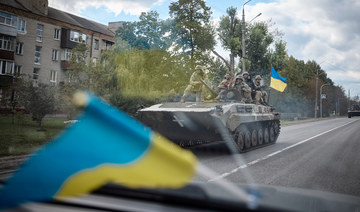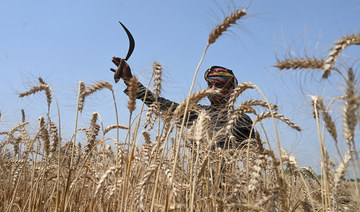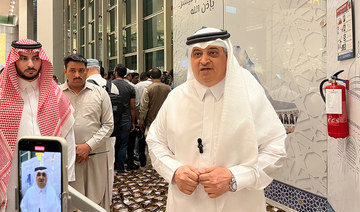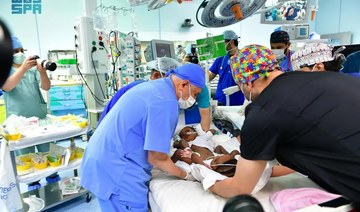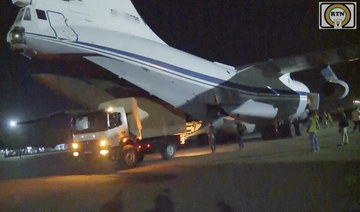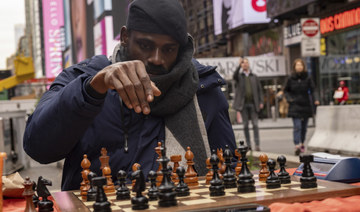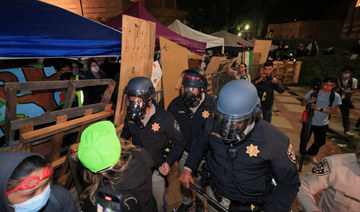ISTANBUL: Russia and Ukraine have agreed to swap 200 prisoners in one of the largest exchanges of the seven-month war, Turkish President Recep Tayyip Erdogan told US television.
Erdogan made the announcement after talks last week with Russian President Vladimir Putin on the sidelines of a regional summit in Uzbekistan.
Erdogan did not provide full details about the swap, calling the people being exchanged “hostages” and not saying how many there were from each side.
“Two hundred hostages will be exchanged upon agreement between the parties. I think a significant step will be taken forward,” Erdogan told PBS television late Monday.
NATO member Turkey has tried to stay neutral in the conflict, supplying combat drones to Kyiv and shying away from Western-led sanctions against Moscow.
Erdogan said he had the “impression” that Putin was willing to end the war.
“We had very extensive discussions and he is actually showing me that he is willing to end this as soon as possible,” Erdogan said.
“That was my impression because the way things are going right now are quite problematic.”
Erdogan said Russia’s return of captured lands would be an important part of any lasting truce.
“If peace is going to be established in Ukraine, of course returning the land that was invaded will become important,” he said.
Asked repeatedly if Putin should be held responsible for invading Ukraine, Erdogan said there was no benefit in taking sides.
“We are not going to defend a single leader. Instead, we have to look for a solution that will satisfy all the parties involved.”
Erdogan has repeatedly tried to bring Putin and Ukrainian President Volodymyr Zelensky together in Turkey for truce talks.
Russia, Ukraine agree to swap 200 prisoners: Erdogan
https://arab.news/j5zeh
Russia, Ukraine agree to swap 200 prisoners: Erdogan

- Turkish President Recep Tayyip Erdogan did not provide full details about the swap
Saudi team in Manila to transport Filipino conjoined twins for surgery in Riyadh
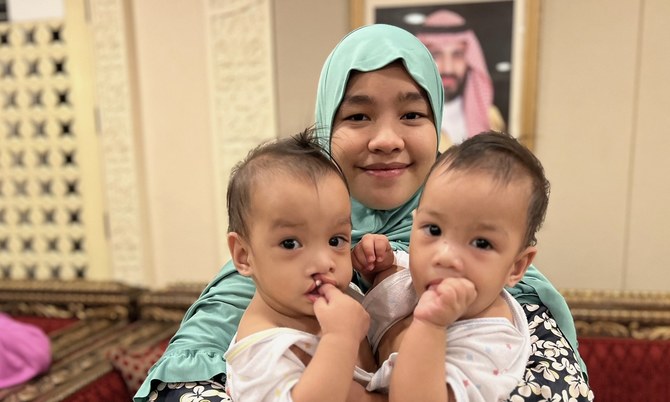
- Akhizah and Ayeesha Yusoph will fly to Saudi Arabia aboard medical aircraft on Sunday
- First Filipino conjoined twins underwent successful separation surgery in Riyadh in 2004
MANILA: A Saudi medical team has arrived in Manila to transport two 16-month-old girls to Riyadh, who will undergo separation surgery in the capital under the Kingdom’s flagship program for conjoined twins.
Akhizah and Ayeesha Yusoph were born in Panabo City, Davao Del Norte province on the southern island of Mindanao in December 2022. Their bodies share one liver.
“It was in the seventh month that I found out that they were conjoined, when I had my ultrasound. I was shocked,” the children’s mother, Hashima Yusoph, told Arab News.
“All I was thinking at that time was how I can take care of them, how I can do my best to be a mother.”
Not knowing how to help her newborns, the 19-year-old started to look for help to make sure the girls would have a life that is as normal as it could be. It was when they were five months old that a local charity connected her with the King Salman Humanitarian Aid and Relief Center.
KSrelief was established by King Salman in 2015 and is headed by Dr. Abdullah
Al-Rabeeah, one of the world’s most renowned pediatric surgeons.
The Saudi Conjoined Twins Program spearheaded by Al-Rabeeah has, since 1990, separated more than 130 children from 25 countries, who were born sharing internal organs with their twins.
Akhizah and Ayeesha will be transported to Riyadh on a special medical aircraft on Sunday.
A reception in their and the KSrelief team’s honor was held by Saudi Ambassador Hisham Al-Qahtani on Friday.
The ambassador said that all the medical procedures, transportation and their stay in the Kingdom during treatment will be covered by the Saudi government, following King Salman’s decree.

“This royal initiative comes as part of the Kingdom’s wise leadership commitment — may God preserve it — to care for and concentrate on humanitarian work,” he told the guests and media.
“This humanitarian work reflects one of the prominent achievements of the Kingdom in the field of separating conjoined twins and providing outstanding medical care, where the Kingdom has become a pioneer in the field.”
Akhizah and Ayeesha will fly to Saudi Arabia with their mother and grandmother.
“I’m so happy it’s finally happening ... The doctors said they are very fit to undergo surgery,” Hashima said. “This is really life changing for us.”
Conjoined twins are a rare phenomenon, estimated to occur once in every 50,000 to 60,000 births.
In March 2004, another set of Filipino conjoined twins, Ann and Mae Manzo, underwent separation surgery in Riyadh.
Joined at the abdomen, the pelvis and the perineum, they were successfully operated on in King Abdulaziz Medical City by Al-Rabeeah and his team of 50 doctors and nurses.
Police clear pro-Gaza sit-in at top Paris university

- Administrators had closed Sciences Po’s main buildings in response to the sit-in and called for remote classes instead
- Protests have been slow to spread to other prominent universities
PARIS: Police entered Paris’ Sciences Po university on Friday to remove dozens of students staging a pro-Gaza sit-in in the entrance hall, AFP journalists saw, as protests fire political debate about the Israeli-Palestinian conflict.
One student told reporters “around 50 students were still inside the rue Saint-Guillaume site” when police entered.
Bastien, 22, told AFP he and other protesters had been peacefully brought out in groups of 10 by officers.
Another, Lucas, studying for a master’s degree, said “some students were dragged and others gripped by the head or shoulders.”
Administrators had closed Sciences Po’s main buildings on Friday in response to the sit-in and called for remote classes instead.
They said “around 70 to 80 people” were occupying the foyer of the central Paris building.
Prime Minister Gabriel Attal’s office said such protests would be dealt with using “total rigour,” adding that 23 university sites had been “evacuated” on Thursday.
Students from the university’s Palestine Committee had earlier told reporters they faced a “disproportionate” response from police, who had blocked access to the site before moving in.
They also complained of a lack of “medical assistance” for seven students who had started a hunger strike “in solidarity with Palestinian victims.”
Widespread protests
Sciences Po, widely considered France’s top political science school, with alumni including President Emmanuel Macron, has seen student action at its at sites across the country in protest against the war in Gaza and the ensuing humanitarian crisis.
Protests have been slow to spread to other prominent universities, unlike in the United States — where demonstrations at around 40 facilities have at times spiralled into clashes with police and mass arrests.
But demonstrations have so far been more peaceful in France, home to the largest Jewish population outside Israel and the US, and to Europe’s largest Muslim community.
The University of California, Los Angeles, announced that Friday’s classes would be held remotely after police cleared a protest camp there and arrested more than 200 people.
Sciences Po administration took the same step for its Paris student body of between 5,000 and 6,000.
Protesters occupied the entrance hall in a “peaceful sit-in” following a debate on the Middle East with administrators on Thursday morning that their Palestine Committee dubbed “disappointing.”
The university’s interim administrator, Jean Basseres, refused student demands to “investigate” Science Po’s ties with Israeli institutions.
War on Gaza
The war in Gaza began after Palestinian militant group Hamas launched an attack on Israel on October 7 that resulted in the deaths of 1,170 people, mostly civilians, according to an AFP tally of Israeli official figures.
Israel estimates that 129 hostages seized by militants during their attack remain in Gaza. The Israeli military says it believes 34 of them are dead.
Israel’s relentless retaliatory offensive on Gaza has killed at least 34,596 people in the Palestinian territory, mostly women and children, according to the besieged enclave’s Hamas-run health ministry.
Outside the Sorbonne University, a few hundred meters (yards) from Sciences Po in central Paris, members of the Union of Jewish Students in France (UEJF) were setting up a “dialogue table” on Friday.
“We want to prove that it’s not true that you can’t talk about the Israeli-Palestinian conflict,” UEJF president Samuel Lejoyeux told broadcaster Radio J.
“To do that, we have to sideline those who single out Jewish students as complicit in genocide,” he added.
In the northeastern city of Lille, the ESJ journalism school was blocked off, an AFP reporter saw.
Students at the city’s nearby branch of Sciences Po had their identities checked before they were allowed in via a back entrance to sit exams.
Around 100 students had occupied a lecture hall at Science Po’s Lyon branch late on Thursday, while a blockade at a university site in nearby Saint-Etienne was cleared on Thursday morning by police.
Cockfights still rule the roost in India’s forest villages

- India is renowned for its fanatical cricket obsession but in the central state of Chhattisgarh, cockfighting draws the crowds
- When a cockfight is on calendar, hundreds of men walk far across rivers, through dense bushland and over hills for ringside view
KATEKALYAN: The swing of a talon and a flurry of feathers leaves a rooster motionless, a cockfight bout viewed as cruel by many but which binds disparate Indian forest communities together.
India is renowned for its fanatical cricket obsession but in the central state of Chhattisgarh, cockfighting draws the crowds.
“Earlier there was no other entertainment and it helped us meet people from other villages,” Raju, whose skill in raising fighting fowl has made him something of a local celebrity, told AFP.
“Even with all the changes around us today, the sport is still very popular,” the 32-year-old added.
The forests of Bastar district are home to numerous tribal communities living in scattered villages.
India has pumped millions of dollars into infrastructure development, and new roads and mobile phone towers have brought the forest’s inhabitants somewhat closer to the outside world.
Rugged terrain and the tyranny of distance in remote Bastar district still lend few occasions for these villages to interact with each other.
But when a cockfight is on the calendar, hundreds of men will walk far across rivers, through dense bushland and over hills to get a ringside view.
“I do nothing but organize fights, raise roosters and place bets,” Bhagat, 35, of Katekalyan village told AFP.
Last month was Katekalyan’s turn to host a bout, with men from out of town ringing the fence of the dirt enclosure where roosters spar.
Most cockfights are over in the blink of an eye, with the pre-game pageantry accounting for most of the action.
Bhagat and a rival rooster owner first hold their bird’s beak to beak to gauge whether they have the necessary hostility to battle.
Both men then use twine to fix sharp blades to the claws of their charges as the crowd shouts out their small wagers on the outcome.
Along with much of the rest of the world, cockfighting is banned in numerous Indian states on animal cruelty grounds.
People for the Ethical Treatment of Animals (PETA) India calls cockfighting “barbaric,” and campaigns to shut it down for good.
But the men living in Bastar’s forests see it as an integral part of their community fabric.
Roosters that survive multiple bouts are lauded alongside their owners.
Raju said the most enduring fighters were locally remembered with the same reverence that the rest of India holds for cricketing greats like former captain Sachin Tendulkar.
“Like you have a field for cricket, this is our field,” he said.
“And the winners get fame and respect, just like Sachin did by scoring all his runs.”
Bhagat said it always grieved him when one of his animals died in combat.
“When we lose a rooster in the fight, our hearts are in pain for a few days,” he said.
“But then we get drunk, and then there will be peace.”
Russian troops enter base housing US military in Niger, US official says
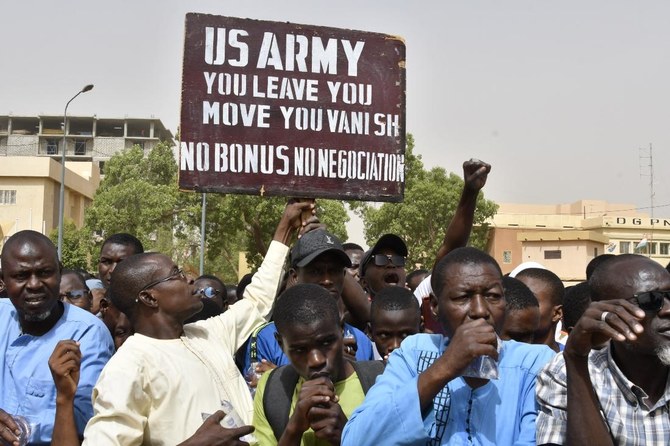
- The US and its allies have been forced to move troops out of a number of African countries following coups
WASHINGTON: Russian military personnel have entered an air base in Niger that is hosting US troops, a senior US defense official told Reuters, a move that follows a decision by Niger’s junta to expel US forces.
The military officers ruling the West African nation have told the US to withdraw its nearly 1,000 military personnel from the country, which until a coup last year had been a key partner for Washington’s fight against insurgents who have killed thousands of people and displaced millions more.
A senior US defense official, speaking on condition of anonymity, said Russian forces were not mingling with US troops but were using a separate hangar at Airbase 101, which is next to Diori Hamani International Airport in Niamey, Niger’s capital.
The move by Russia’s military, which Reuters was the first to report, puts US and Russian troops in close proximity at a time when the nations’ military and diplomatic rivalry is increasingly acrimonious over the conflict in Ukraine.
It also raises questions about the fate of US installations in the country following a withdrawal.
“(The situation) is not great but in the short-term manageable,” the official said.
Asked about the Reuters report, US Defense Secretary Lloyd Austin played down any risk to American troops or the chance that Russian troops might get close to US military hardware.
“The Russians are in a separate compound and don’t have access to US forces or access to our equipment,” Austin told a press conference in Honolulu.
“I’m always focused on the safety and protection of our troops ... But right now, I don’t see a significant issue here in terms of our force protection.”
The Nigerien and Russian embassies in Washington did not immediately respond to a request for comment.
The US and its allies have been forced to move troops out of a number of African countries following coups that brought to power groups eager to distance themselves from Western governments. In addition to the impending departure from Niger, US troops have also left Chad in recent days, while French forces have been kicked out of Mali and Burkina Faso.
At the same time, Russia is seeking to strengthen relations with African nations, pitching Moscow as a friendly country with no colonial baggage in the continent.
Mali, for example, has in recent years become one of Russia’s closest African allies, with the Wagner Group mercenary force deploying there to fight jihadist insurgents.
Russia has described relations with the United States as “below zero” because of US military and financial aid for Ukraine in its effort to defend against invading Russian forces.
The US official said Nigerien authorities had told President Joe Biden’s administration that about 60 Russian military personnel would be in Niger, but the official could not verify that number.
After the coup, the US military moved some of its forces in Niger from Airbase 101 to Airbase 201 in the city of Agadez. It was not immediately clear what US military equipment remained at Airbase 101.
The United States built Airbase 201 in central Niger at a cost of more than $100 million. Since 2018 it has been used to target Islamic State and Al-Qaeda affiliate Jama’at Nusrat Al-Islam wal Muslimeen (JNIM) fighters with armed drones.
Washington is concerned about Islamic militants in the Sahel region, who may be able to expand without the presence of US forces and intelligence capabilities.
Niger’s move to ask for the removal of US troops came after a meeting in Niamey in mid-March, when senior US officials raised concerns including the expected arrival of Russia forces and reports of Iran seeking raw materials in the country, including uranium.
While the US message to Nigerien officials was not an ultimatum, the official said, it was made clear US forces could not be on a base with Russian forces.
“They did not take that well,” the official said.
A two-star US general has been sent to Niger to try and arrange a professional and responsible withdrawal.
While no decisions have been taken on the future of US troops in Niger, the official said the plan was for them to return to US Africa Command’s home bases, located in Germany.
’Show solidarity’: Pro-Palestinian protesters camp across Australian universities
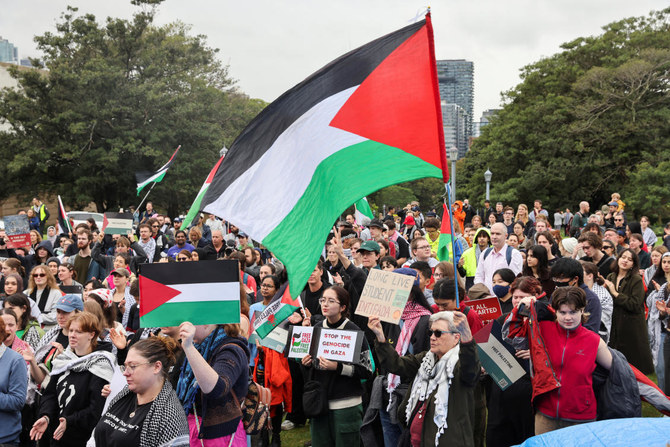
- Pro-Palestinian activists set up an encampment last week outside the sandstone main hall at University of Sydney
- Similar camps have sprung up at universities in Melbourne, Canberra and other Australian cities
SYDNEY: Hundreds of people protesting Israel’s war in Gaza rallied at one of Australia’s top universities on Friday demanding it divest from companies with ties to Israel, in a movement inspired by the student occupations sweeping US campuses.
Pro-Palestinian activists set up an encampment last week outside the sandstone main hall at University of Sydney, one of Australia’s largest tertiary institutions.
Similar camps have sprung up at universities in Melbourne, Canberra and other Australian cities.
Unlike in the US, where police have forcibly removed scores of defiant pro-Palestinian protesters at several colleges, protest sites in Australia have been peaceful with scant police presence.
On Friday, protesters rallied to demand University of Sydney divest from companies with ties to Israel, echoing calls from students in the US, Canada and France.
Standing in the chanting crowd of more than 300 with his two-year old son on his shoulders, Matt, 39, said he came to show it was not just students angry at Israel’s actions in Gaza.
“Once you understand what is going on you have a responsibility to try and get involved and raise awareness and show solidarity,” he told Reuters, declining to give his last name.
Several hundred meters away from the Sydney university protest and separated by lines of security guards, hundreds gathered under Australian and Israeli flags to hear speakers say the pro-Palestinian protests made Jewish students and staff feel unsafe on campus.
“There’s no space for anybody else, walking through campus chanting ‘Intifada’ and ‘from the river to the sea’ it does something, it’s scary,” said Sarah, an academic who declined to give her name for fear of repercussions.
University of Sydney vice chancellor Mark Scott told local media on Thursday the pro-Palestinian encampment could stay on campus in part because there was not the violence seen in the US
While several police cars were parked at the entrance to the university, no police were present at either protest.
Long a stalwart ally of Israel, Australia has become increasingly critical of its conduct in Gaza, where an Australian aid worker was killed in an Israeli attack last month.
Pro-Palestinian protesters said the government had not done enough to push for peace and led the crowd in chants against Prime Minister Anthony Albanese and his government.



